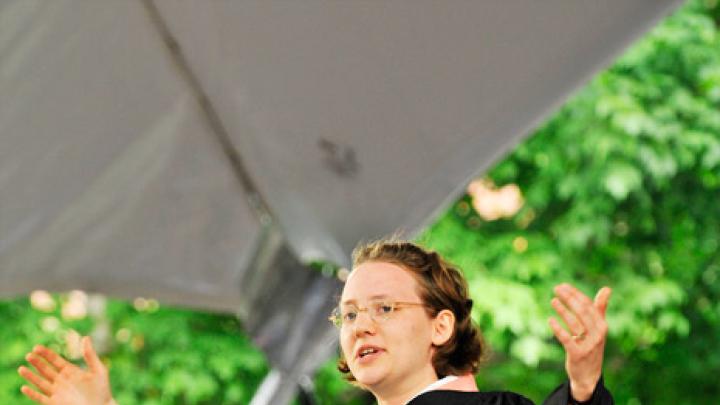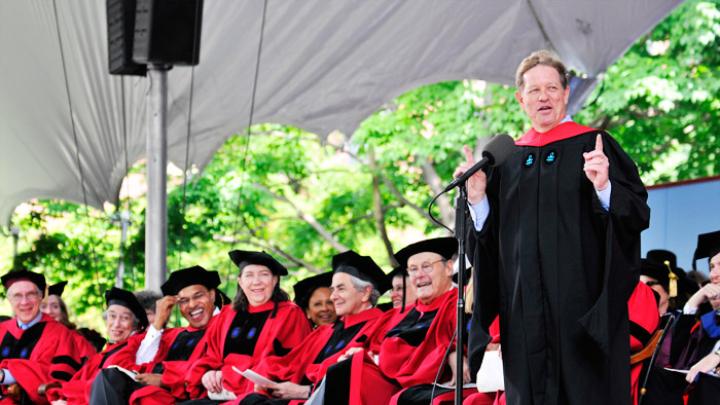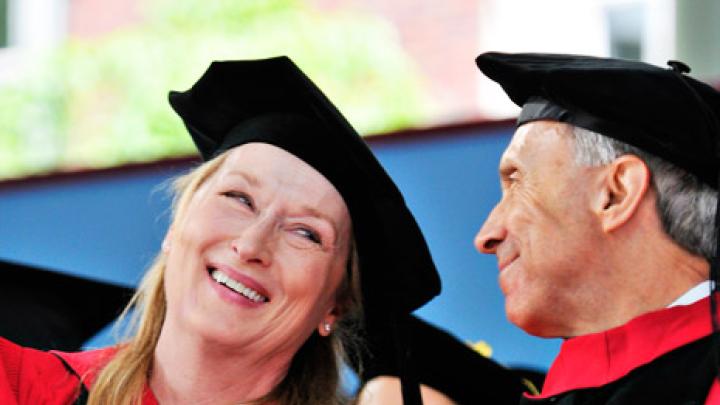In a cerebral yet heartfelt Commencement address, the Honorable David H. Souter ’61, LL.B. ’66, former associate justice of the U.S. Supreme Court, spoke of the necessity in constitutional law to choose between “values that may very well exist in tension with each other,” pointing out that decisions are never “straightforward exercise[s] of reading fairly and viewing facts objectively.” The Constitution, he declared, reflects “the desire of the American people…to have things both ways. We want order and security, and we also want liberty…These pairs of desires…can clash.”
He presented to the Harvard Alumni Association (HAA)—including its newest members, the graduates of 2010—two famous cases that illustrate the subtleties and difficulties of constitutional law. The first case, argued before the Supreme Court in 1971, involved the right of newspapers to publish classified documents relating to the Vietnam War, the Pentagon Papers. This case showed “that the Constitution is no simple contract,” Souter said. “Its language grants and guarantees many good things…that compete with each other and can never all be realized.” The lawyer for the U.S. government, Erwin Griswold, dean of Harvard Law School from 1946 until 1967, argued that national security in this case was a more pressing consideration than the First Amendment’s protection of freedom of speech. When Justice Black pointed out that the Amendment absolutely prohibited a law restricting the freedom of the press, Griswold answered that the unconditional language of the Amendment only had to be obeyed conditionally. Although the newspapers won the case, Justice Souter cautioned that “the Constitution has to be read as a whole, and when it is, other values crop up in potential conflict with unfettered rights to publish.”
Souter’s next example further reinforced his argument that deciding constitutional cases is far more than the "fair reading" model would suggest. He compared two cases whose salient facts, he said, were essentially equivalent: the 1896 case of Plessy v. Ferguson, where the Supreme Court decided that it was not unconstitutional to require black people to ride in separate railroad cars, and 1954’s Brown v. Board of Education, in which racial segregation in schools was declared unconstitutional. Both cases hinged on whether the idea of ‘separate but equal’ was constitutional, and different conclusions were reached in each. If constitutional judging is “merely fair reading of language applied to facts objectively viewed,” Souter argued, then Plessy must be regarded as fair, and Brown as “flat-out wrong or…very mystifying.” The Constitution’s guarantee of equal protection had not changed from 1896 to 1954, Souter reminded his audience, and “if Plessy was not wrong, how is it that Brown came out so differently?”
It was a difference in perspective that made the Brown decision possible, he said. Pointing out that “judicial perception turns on the experience of the judges, and on their ability to think from a point of view that is different from their own,” Souter explained that for the justices of 1954, who lacked the living memory of slavery that the 1896 justices had, enforced segregation could only express a judgment of inferiority, and was thus unconstitutional.
Summing up his speech, Souter recalled his youthful dismay at the pronouncement by an earlier associate justice, Oliver Wendell Holmes, Jr., AB 1861, J.D. ’66, that “certainty generally is illusion and repose is not our destiny.” But experience, he said, has taught him that this insight is compatible with a tempered optimism, with the belief that “in an indeterminate world…it is still possible to live fully in the trust that a way will be found leading through the future, uncertain as it is…That is how a judge lives in a state of trust, and I know of no other way to make good on the aspirations that tell us who we are, and who we mean to be, as the people of the United States.”
View part 2 of Souter's speech, and part 3.
A video of Souter's complete speech is posted on Vimeo.
A video archive of the Morning Exercises and Afternoon Exercises is available from www.harvard.edu.












